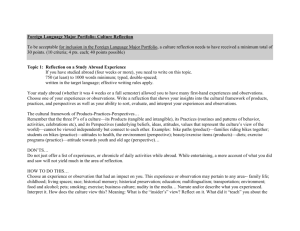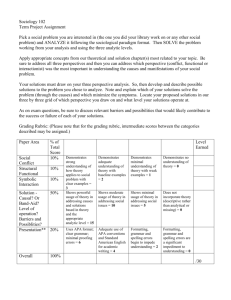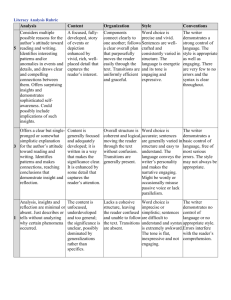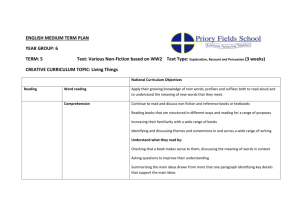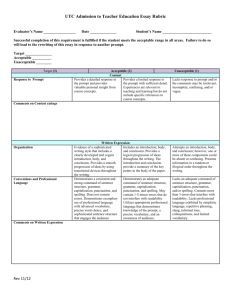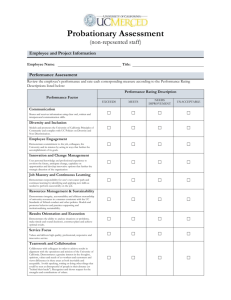FLG Culture Reflection Topic 2
advertisement
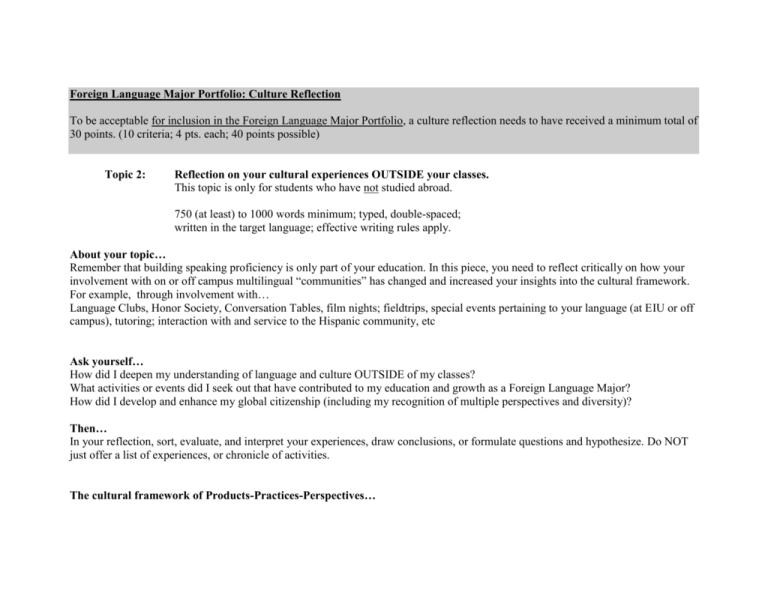
Foreign Language Major Portfolio: Culture Reflection To be acceptable for inclusion in the Foreign Language Major Portfolio, a culture reflection needs to have received a minimum total of 30 points. (10 criteria; 4 pts. each; 40 points possible) Topic 2: Reflection on your cultural experiences OUTSIDE your classes. This topic is only for students who have not studied abroad. 750 (at least) to 1000 words minimum; typed, double-spaced; written in the target language; effective writing rules apply. About your topic… Remember that building speaking proficiency is only part of your education. In this piece, you need to reflect critically on how your involvement with on or off campus multilingual “communities” has changed and increased your insights into the cultural framework. For example, through involvement with… Language Clubs, Honor Society, Conversation Tables, film nights; fieldtrips, special events pertaining to your language (at EIU or off campus), tutoring; interaction with and service to the Hispanic community, etc Ask yourself… How did I deepen my understanding of language and culture OUTSIDE of my classes? What activities or events did I seek out that have contributed to my education and growth as a Foreign Language Major? How did I develop and enhance my global citizenship (including my recognition of multiple perspectives and diversity)? Then… In your reflection, sort, evaluate, and interpret your experiences, draw conclusions, or formulate questions and hypothesize. Do NOT just offer a list of experiences, or chronicle of activities. The cultural framework of Products-Practices-Perspectives… Remember that the three P’s of a culture—its Products (tangible and intangible), its Practices (routines and patterns of behavior, activities, celebrations etc), and its Perspectives (underlying beliefs, ideas, attitudes, values that represent the culture’s view of the world)—cannot be viewed independently but connect to each other. Examples: bike paths (product)—families riding bikes together; students on bikes (practice)—attitudes to health, the environment (perspective); beauty/exercise items (products)—diets; exercise programs (practice)—attitude towards youth and old age (perspective)… 10 criteria Areas CONTENT Demonstrating Cultural Understandings (ACTFL 2.a.) Global Citizenship Specifications 1 Does not Meet Expectations (Unsatisfactory) Cultural Understandings and Connections Demonstrates insufficient or inaccurate understanding of the connections among the perspectives of a culture and its practices and products. 2 Sometimes Meets Expectations (Needs Improvement) Demonstrates sometimes insufficient or inaccurate understanding of the connections among the perspectives of a culture and its practices and products. Comparisons Demonstrates insufficient understanding of the similarities and differences between the target and heritage cultures. Does not demonstrate recognition of multiple perpectives and diversity. Demonstrates sometimes insufficient understanding of the similarities and differences between the target and heritage cultures. Inconsistent evidence of recognition of multiple perspectives and diversity. 3 Meets Expectations (Satisfactory) 4 Exceeds Expectations (Superior) Demonstrates that s/he understands the connections among the perspectives of a culture and its practices and products. Demonstrates understanding of the similarities and differences between the target and heritage cultures. Recognizes multiple perspectives and diversity. Demonstrates that s/he thoroughly understands the connections among the perspectives of a culture and its practices and products. Demonstrates a thorough understanding of the similarities and differences between the target and heritage cultures. Recognizes multiple perpectives and diversity. Displays civic engagement. Score Critical Thinking (sorting, evaluating, interpreting, hypothesizing) Analysis is based on discrete pieces of cultural information, or limited to anecdotes. Lacks evidence of critical thinking. Analysis is sometimes based on discrete pieces of cultural information, or limited to anecdotes. Inconsistent evidence of critical thinking. at least 750 words in length below 500 500-649 Organization Paragraphs; focus; development of ideas supported by details Does not present information in any sequence. Jumps around. Reader cannot follow for the most part. Presents information in some sequence. Reader can follow sometimes. Target Language Use Style (vocabulary; sentence structure) Uses style that is inappropriate to the assignment and/or language level expected. No variety in expression and sentence structure Uses style that is frequently inappropriate to the assignment and/or language level expected. Little variety in expression and sentence structure. Vocabulary Numerous errors in vocabulary. Errors prevent reader from Frequent errors in vocabulary. Errors distract the reader. Critical Thinking FORM Length Demonstrates that s/he can analyze observed differences and hypothesize about unfamiliar or unknown cultural issues. Some evidence of critical thinking. 650-749 Demonstrates that s/he can skillfully analyze observed differences. Demonstrates that s/he can pose significant cultural questions. Strong evidence of critical thinking. Presents information in the required and logical sequence. Reader can follow most of the time. Uses style that is mostly appropriate to the assignment and/or language level expected. Uses some variation in expression and sentence structure. Some errors in vocabulary. Some errors may Presents information in the required as well as logical and interesting sequence. Reader can easily follow. 750+ Uses style that is appropriate for the assignment and/or language level expected. Uses variation in expression and sentence structure. No, or few errors in vocabulary. Errors are not distracting.. following. Grammar (subject-verb agreement; sentence structure; gender; case; number etc) Numerous errors in grammar. Errors prevent reader from following. Frequent errors in grammar. Errors distract the reader. be distracting to the reader. Some errors in grammar. Some errors may be distracting to the reader. Form and Mechanics Numerous errors in spelling and punctuation. Frequent errors in spelling and punctuation. Some errors in spelling and punctuation. No, or few errors in grammar. Errors are not distracting. No, or very few errors in spelling and punctuation. Final Score Evaluate d by: (Signatur e)
